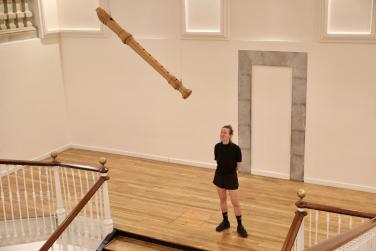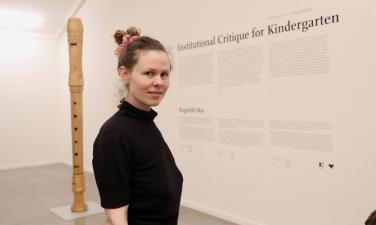Sound installation by Ragnhild May in the frame of the project Scala.


Musical instruments can be seen as extensions of the body: humans can for example whistle using the mouth or hands, thus a flute seems like a natural prolongation of the body to create a more powerful or varied tone. The instrument can be seen as a kind of prosthesis in a cyborgian symbiosis with the body. Specific ideas are linked to this interaction. An instrument relates to the scale of the human body and the ear’s ability to sense specific frequency specters. Traditional Western instruments are conformed to an aesthetic within the Western canon that culturally is dominated by men. The primary instrument in Western music, the piano, is designed for the size of an average male hand, and generally Western musical instruments are designed for the able bodied male. Instruments shape the way we play them, the way the body interacts with them. How does the shape of the instrument affect the sound that they produce? Can we imagine other kinds of instrumental practices? Other kinds of music?
The oldest archeological findings of instruments are bone whistles that resemble modern whistles and are close to 40,000 years old. Archaeologists suggest that whistles “could have contributed to the maintenance of larger social networks, and thereby perhaps have helped facilitate the demographic and territorial expansion of modern humans.” All over the world, different cultures have versions of end blown whistles. The most widespread version of end-blown whistles, the recorder (or block flute), was developed in Europe in the Middle Ages, and was widely used from the second half of the 15th century through to the 17th century. From the late 18th century, the recorder whistle was increasingly overlooked and almost forgotten, because of the invention of the transverse flute.
In the 1920s, the German pedagogue Carl Orff, together with Gunild Keetman developed Music for Children, an innovative theory about children’s music education. In Music for Children the role of the recorder whistle was to be a learning tool before advancing to “real” instruments. Today the recorder whistle is still widespread in schools around the world as a learning instrument. Plastic soprano whistles can be bought for around 5€ and this accessibility makes it an ideal instrument for early musical training.
The installation Institutional Critique for Kindergarten reflects on children’s education, the cultural history of whistles as well as the relation between body and instrument. It consists of two upscaled whistles made of pine and oak and a multi-channel sound installation comprising a poly-rhythmic composition for whistles, made with a computer controlled whistle instrument, designed by the artist. The computer-controlled instrument makes very advanced polyrhythms possible, polyrhythms so complex that they are impossible or very difficult to play for humans, but simple to create on a computer, thus mixing digital with analog or creating techno music for whistles.
TECHNICAL DETAILS
From Monday to Sunday 9:00 to 22:00
2022/07/14 - 2022/10/23
Sound installation created at the invitation of Tabakalera.
Curated by Oier Etxeberria.
